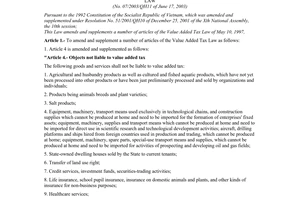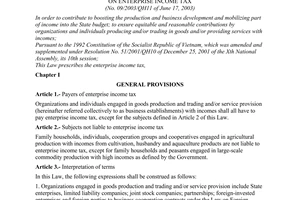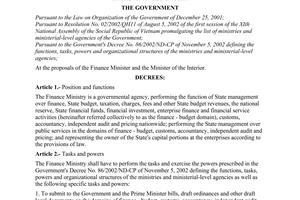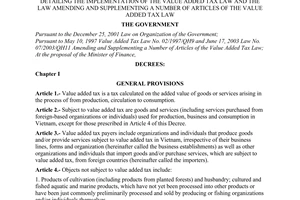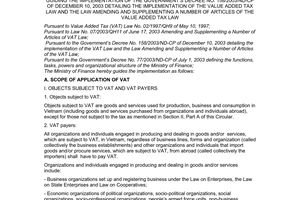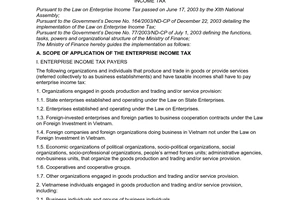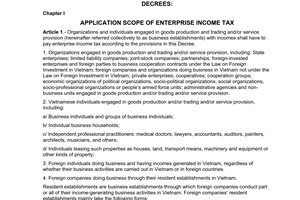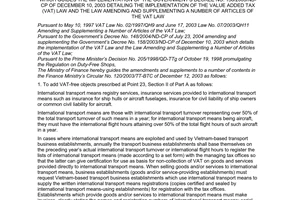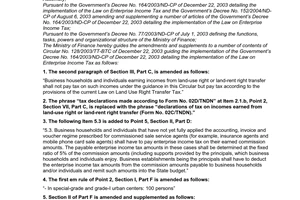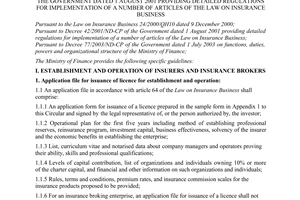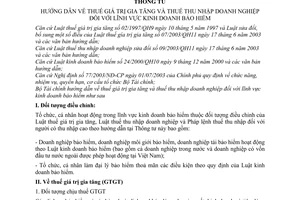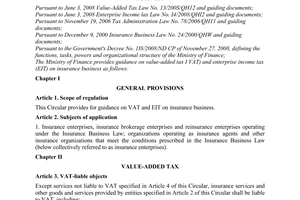Circular no. 111/2005/TT-BTC of December 13, 2005 guiding value added tax and enterprise income tax for insurance business đã được thay thế bởi Circular No. 09/2010/TT-BTC guiding Value-Added tax and enterprise Income Tax và được áp dụng kể từ ngày 07/03/2011.
Nội dung toàn văn Circular no. 111/2005/TT-BTC of December 13, 2005 guiding value added tax and enterprise income tax for insurance business
|
THE
MINISTRY OF FINANCE |
SOCIALIST
REPUBLIC OF VIET NAM |
|
No. 111/2005/TT-BTC |
Hanoi, December 13, 2005 |
CIRCULAR
GUIDING VALUE ADDED TAX AND ENTERPRISE INCOME TAX FOR INSURANCE BUSINESS
Pursuant to Value Added Tax
(VAT) Law No. 02/1997/QH9 of May 10, 1997 and Law No. 07/2003/QH11 of June 17,
2003, amending and supplementing a number of articles of the VAT Law, and their
guiding documents;
Pursuant to Enterprise Income Tax (EIT) Law No. 09/2003/QH11 of June 17, 2003
and its guiding documents;
Pursuant to Insurance Business Law No. 24/2000/QH10 of December 9, 2000 and its
guiding documents;
Pursuant to the Government’s Decree No. 77/2003/ND-CP of July 1, 2003 defining
the functions, tasks, powers and organizational structure of the Finance
Ministry;
The Finance Ministry hereby provides guidance on VAT and EIT for insurance
business as follows:
I. SUBJECTS OF REGULATION
Subjects of regulation are organizations and individuals engaged in insurance business and governed by the VAT Law, the EIT Law and the Ordinance on Income Tax on High-Income Earners under the guidance in this Circular, including:
- Insurance enterprises, insurance brokerage enterprises, reinsurance enterprises operating under the Insurance Business Law (including both domestic and foreign-invested enterprises licensed to operate in Vietnam);
- Organizations and individuals operating as insurance agents that meet the conditions stipulated in the Insurance Business Law.
II. ON VAT
1. VAT-liable objects
Insurance services and other goods and services used for production, business and/or consumption in Vietnam (except for services not liable to VAT specified at Point 2 of this Circular) shall all be liable to VAT, including:
- Non-life insurance services (except those specified at Point 2 below);
- Expertise, indemnity consideration, third party’s refund-claiming agency services;
- Other goods and services liable to VAT under the provisions of the VAT law.
2. Objects not liable to VAT
The following insurance services shall not be liable to VAT:
- Life insurance; pupil insurance and human insurance services such as insurance for seafarer, crewmember and human accidents (covering also accident insurance, life-cum-hospitalization insurance), passenger accident insurance, tourist insurance, insurance for drivers, assistant drivers and people onboard vehicles, insurance for persons on sterilization, post-operation hospitalization insurance, personal life insurance and other human-related insurance.
- Insurance for domestic animals, plants and other agricultural insurance services;
- Social, health, labor and unemployment insurance;
- Insurance services provided for means of international transport such as for ship hulls or fuselages, for civil liabilities of ship owners or for general civil liabilities for airplanes.
A means of international transport is the one whose international transport turnover represents over 50% of its total turnover in a year; if it is an airplane, the number of international flight hours of such plane must represent over 50% of its total flight hours in a year.
- Insurance for petroleum works and equipment (including oil tankers bearing foreign nationalities), which are hired by oil and gas contractors or sub-contractors for operation in Vietnam’s exclusive economic sea areas (including contiguous areas subject to the common exploitation regime already agreed between Vietnam and foreign countries with adjacent or opposite seashores);
- Insurance for exports transported by land, sea, river, railway or air; crude oil sold to foreign countries;
- Reinsurance overseas;
3. VAT payers
VAT payers guided in this Circular are insurance enterprises, insurance brokerage enterprises, reinsurance enterprises and other insurance organizations (referred to collectively as insurance enterprises) which deal in VAT-liable goods and/or services specified at Point 1, Section II of this Circular.
4. Tax calculation prices
The VAT calculation price for insurance services and other services and goods supplied by insurance enterprises are determined as follows:
4.1. For insurance services, it is the VAT-exclusive original insurance premium (covering also surcharges and additional charges besides the service charges to which an insurance enterprise is entitled, except for surcharges and charges it has to remit into the state budget).
- Where particular vouchers used for collection of insurance premiums are recorded with VAT-inclusive insurance premium-payment prices, the VAT-exclusive insurance premium shall be determined as follows:
The VAT-exclusive insurance premium (price without VAT) = The insurance premium (payment price) : [1 + Tax rate (10%)]
- Where insurance contracts, applications or certificates contain agreements on periodical collection of premiums, the VAT calculation price shall be the insurance premium amount paid periodically; in case of an agreement on lump-sum payment of insurance premiums, the VAT calculation price shall be the VAT-exclusive premium amounts already paid in lump sum.
- In case of coinsurance, if the contract clearly states coinsurance percentages, the VAT calculation price shall be the VAT-exclusive original insurance premium apportioned to each coinsurance enterprise corresponding to such percentages.
Where a coinsurance contract has only one leading enterprise responsible for collecting the insurance premiums, the VAT calculation price shall be the original insurance premium of the entire value of the insurance contract, exclusive of VAT.
4.2. For expertise, indemnity consideration or third party’s refund-claiming agency services or goods handling agency for 100% indemnity for remuneration or commission, the VAT calculation price shall be the VAT-exclusive remuneration or commission amount (not yet deducted to offset any expenses) collected by the concerned insurance enterprise.
4.3. For other goods and services liable to VAT, their tax calculation prices shall comply with the Finance Ministry’s Circular No. 120/2003/TT-BTC of December 12, 2003, guiding the implementation of the Government’s Decree No. 158/2003/ND-CP which details the implementation of the VAT Law.
5. Tax rates
5.1. The tax rate of 0% shall apply to services provided to export-processing enterprises, including insurance services, services of expertise agency, indemnity-consideration agency, agency for claiming refund by the third party and goods handling agency for 100% indemnity.
5.2. The tax rate of 10% shall apply to insurance business activities (covering also insurance brokerage), including insurance services and such agency services as damage expertise, indemnity consideration, claim for refund by the third party, and other insurance business services (except for those not liable to VAT as specified at Point 2 and those entitled to the tax rate of 0% as defined at Item 5.1, Point 5, Section II of this Circular).
5.3. With regard to other business activities apart from the above-said insurance business activities, the tax rates prescribed for specific types of goods and services mentioned in Section II, Part B of the Finance Ministry’s Circular No. 120/2003/TT-BTC of December 12, 2003 shall apply.
6. Tax calculation methods
6.1. Insurance enterprises shall pay VAT by tax credit method guided at Point 1, Section III, Part B of Circular No. 120/2003/TT-BTC specifically:
The payable VAT amount = The output VAT amount – The input VAT credit
Of which:
a/ The output VAT amount shall be equal to (=) the service and goods sale turnover subject to VAT multiplied by the corresponding tax rate.
The service and goods sale turnovers subject to VAT include the insurance business turnover and turnovers from other service and goods dealings (besides insurance business activities), which are liable to VAT. The insurance business turnover itself includes:
- The original insurance premiums of VAT-liable insurance services;
- The turnover from expertise agency (excluding charges of mutual expertise for internal accounting member units of the same corporation or company), indemnity-consideration agency, agency for claiming refund by the third party, goods handling agency for 100% indemnity and other turnovers from insurance business activities.
The time for determination of VAT-liable turnovers shall be the time an insurance contract is concluded between an insurance enterprise and an insurance buyer or there is evidence that an insurance enterprise has accepted to provide insurance for a buyer who has paid the insurance premium, even in cases where the enterprise has agreed to allow the buyer to owe an insurance premium debt; or the time an insurance enterprise issues a sale invoice.
b/ The service and goods sale turnovers for which VAT has already been calculated at the original insurance stage shall not be subject to VAT under the provisions of this Circular, including:
- The turnover from reinsurance transfer indemnity and other indemnities (if any).
- The commission from reinsurance ceding and other turnovers related thereto.
- The reinsurance charges and other reinsurance turnovers (covering reinsurance charges paid by insurance enterprises operating within and without the Vietnamese territory).
- The turnover from refund paid by a third party.
c/ Insurance enterprises shall be entitled to input VAT credit on VAT-liable goods and services already purchased for use in insurance business activities which are reflected in purchase VAT invoices under the guidance at Point 1, Section III, Part B of Circular No. 120/2003/TT-BTC.
d/ The input VAT credit for some specific cases shall be made as follows:
- In case of coinsurance, if the contract has only one leading enterprise responsible for collecting the premiums, settling indemnities and paying expenses related to the contract, such enterprise shall be entitled to declare the input VAT credit in VAT invoices with regard to indemnities, insurance commissions and other expenses related to the insurance contract in which it is involved as the leading enterprise, on behalf of coinsuring enterprises under agreement in such contract.
- With regard to goods and services purchased and used for dealing in both VAT-liable goods and services and VAT-free goods and services, enterprises shall be entitled only to the input VAT credit on goods and services used for dealing in VAT-liable ones. Where the input VAT credit cannot be separately accounted, the input tax credit shall be calculated as a percentage (%) of the VAT-liable goods and service sale turnover over the total turnover in the period, of which the VAT-liable turnover and the total turnover of the period shall cover also turnovers for which VAT has been calculated at the original insurance stage as mentioned at Item b, Clause 6.1, Point 6, Section II of this Circular.
- Insurance enterprises must not calculate the input tax credit on goods and services purchased for use in insurance business activities without VAT invoices.
6.2. Adjustment of the input VAT credit: An insurance enterprise must decrease or refund the input VAT credit in cases where their fixed assets, supplies or goods purchased for use for production or trading of VAT-liable goods and/or services have enjoyed the input tax credit but have now shifted to be used for production or trading of those not liable to VAT or for other purposes (even in cases where such fixed assets, supplies or goods should have been used for mortgage but have actually been sold to recover debts owed to financial or credit institutions). The adjusted or refunded VAT amount shall be calculated on the remaining value (exclusive of VAT) of fixed assets; for supplies and goods, the to-be adjusted or -refunded VAT amount shall be the total declared credit amount which has been made upon their purchase.
7. Goods and service sale and purchase invoices and vouchers
7.1. Insurance enterprises shall implement the invoice and voucher regime according to the relevant provisions of law and the guidance in Section IV, Part B of Circular No. 120/2003/TT-BTC.
7.2. A number of specific cases:
7.2.1. With regard to services not liable to VAT mentioned in Item b, Clause 6.1, Point 6, Section II of this Circular, insurance enterprises shall not use VAT invoices for every reinsurance but shall implement the payment voucher regime for reinsurance acceptance and ceding under the provisions of the Finance Ministry’s Decision No. 1296-TC/QD/CDKT of December 31, 1996. Directors of insurance enterprises or reinsurance enterprises shall take responsibility before law for the accuracy and truthfulness of these vouchers, which shall serve as bases for insurance buyers to account their expenses.
7.2.2. In case of coinsurance, if the contract clearly states the coinsurance percentage for each insurance enterprise:
- When collecting insurance premiums, every coinsurance unit shall issue VAT invoices to customers based on the original VAT-inclusive premium corresponding to its coinsurance percentage, and shall make VAT declaration and payment according to regulations.
- When buying goods or services for indemnification or payment of other expenses related to insurance contracts, insurance units shall make input VAT credits and account expenses under regulations corresponding to VAT invoices with their names, addresses and tax identification numbers.
7.2.3. In case of coinsurance, if the contract has only one leading enterprise which is responsible for collecting the premiums, settling indemnities and paying other expenses related to the insurance contract:
- When collecting the insurance premiums, the leading enterprise shall issue VAT invoices to customers, declare, calculate and pay VAT on the total value of the contract in accordance with regulations. When the leading enterprise apportions insurance premiums (exclusive of VAT) to coinsurance units corresponding to their coinsurance percentages, such units shall issue VAT invoices to the leading enterprise, clearly stating the serial number and date of the insurance contract and leaving the VAT line blank and crossed out. Such invoices shall serve as bases for coinsurance enterprises to account their turnovers under regulations.
- When paying under authorization expenses arising under a coinsurance contract such as indemnities, insurance commissions and other expenses related to the contract, the leading enterprise shall declare the input VAT credit for these expenses. When apportioning the expenses to coinsurance units separately according to their respective coinsurance percentages, the leading enterprise shall issue VAT invoices to such units. The invoices must clearly state the expense on indemnities and other expenses related to the coinsurance contract (its serial number and date), performed by the leading enterprise; the VAT line shall be left blank and crossed out. Such invoices shall serve as bases for coinsurance units to account their expenses according to regulations.
7.2.4. For authorized collection and expenditure for other insurance enterprises:
- When collecting insurance premiums under authorization, the authorized collecting enterprises shall have to issue VAT invoices to customers, clearly writing in such invoices that they collect the premiums for insurance companies (names, addresses, tax identification numbers of the companies) according to insurance contracts (numbers and dates of the contracts). The authorized collecting enterprises shall not account their turnovers but account the turnovers collected under authorization, and declare and pay VAT thereon. With regard to authorizing enterprises, when receiving money from the authorized ones, they shall issue VAT invoices to the latter, clearly stating that they have received insurance premiums from the latter (names, addresses, tax identification numbers of the authorized) under insurance contracts (numbers, dates of such contracts); the VAT amounts inscribed in invoices must be equal to those already collected by the authorized collecting enterprises from customers. These invoices shall serve as bases for the authorized collecting enterprises to make input VAT credits when calculating the payable VAT amounts, and also for the authorizing enterprises to account their turnovers, declare and pay VAT according to regulations.
- When spending under authorization money on goods and/or services as indemnities to customers, the authorized spending enterprises shall request organizations or individuals that have supplied goods and/or services to issue sale invoices according to the names, addresses and tax identification numbers of the authorizing enterprises; such invoices shall be transferred to the authorizing enterprises for making input VAT credits (if any) and account expenses in accordance with regulations.
7.2.5. For cases of authorized collection or spending between head-office of an insurance enterprise and its attached units or between its dependent accounting units and its head-office:
- When collecting insurance premiums under authorization, the authorized collecting units shall issue VAT to customers, declare and pay VAT on the collected amounts, and at the same time, issue notices on authorized collection to the authorizing units. Based on authorized collection notices, the authorizing units shall account their turnovers (exclusive of VAT), shall not have to issue invoices, declare and pay VAT on the turnovers collected under authorization.
Where the authorizing units do not request the authorized units to issue VAT invoices to customers, when collecting insurance premiums, the authorized units shall only account the collected amounts and shall neither declare nor pay VAT on such amounts. Based on authorized collection notices, the authorizing units shall issue VAT invoices to customers, declare and pay tax on the collected amounts.
- When making expenses under authorization, the units whose names and tax identification numbers are stated in VAT invoices shall declare and make input VAT credits and, at the same time, notify the authorizing units of the authorized collection for accounting of expenses.
7.2.6. With regard to the refund and reduction of insurance premiums:
Where the insured are business organizations, when refunding insurance premiums (partially or wholly), insurance enterprises shall request such organizations to make VAT invoices, clearly stating the insurance premium amounts refunded by the insurance companies, the VAT amounts and reasons of refund. Such invoices shall serve as bases for insurance enterprises and insured organizations to regulate purchase and sale turnovers, the declared or credited VAT amounts.
Where the insured have no VAT invoices, when refunding insurance premiums, insurance enterprises shall request them to make records or written agreements, clearly stating the refunded insurance premium amounts (exclusive of VAT, the VAT amounts stated in insurance premium receipts (serial numbers and dates) which the insurance enterprises have issued upon premium collection and the reasons for refund. Such documents shall be kept together with premium receipts and serve as bases for insurance enterprises to adjust income declarations and VAT amounts. If the insured cannot supply insurance premium receipts, the premium amounts to be refunded to them and stated in records or written agreements shall be the VAT-exclusive ones.
8. Tax registration, declaration and payment
Insurance enterprises shall register, declare, pay, refund and settle VAT under the guidance in Part C of Circular No. 120/2003/TT-BTC and Circular No. 84/2004/TT-BTC of August 18, 2004, amending and supplementing Circular No. 120/2003/TT-BTC.
Insurance agents enjoying commissions shall not have to declare and pay VAT on agency commissions they are entitled to.
III. ON EIT
1. For insurance enterprises:
1.1. EIT bases
EIT shall be determined as equal to taxable income in a tax calculation period multiplied (x) by the tax rate.
1.1.1. Taxable income in a tax period:
Taxable income in a tax calculation period includes taxable income of insurance business activities, income from financial investments (including overseas investments) and other taxable incomes.
Taxable income in a tax period shall be calculated according to the following formula:
Turnover for
Reasonable
expenses
Taxable
calculation of
taxable
for calculation
of
Other
income in =
income from insurance
- taxable income
from +
taxable
a tax
period
business activities
and
insurance business
incomes
financial activities
activities and
financial
in the tax period
activities in the tax period
1.1.1.1. Turnover for calculation of taxable income in a tax period means the whole amount of money gained from the provision of insurance services, goods and other services, including VAT-exclusive surcharges and additional charges which insurance enterprises are entitled to, including:
a/ Turnover from insurance business, which means the collectible amount of original insurance premiums, agency service charges (for damage expertise, indemnity consideration, claim for refund by the third party, goods handling for 100% indemnity); reinsurance charges; reinsurance commissions and other collectible amounts from insurance business, after subtracting the expenses for reduction incomes such as refund or reduction of insurance premiums, refund or reduction of reinsurance charges; refund or reduction of reinsurance commissions.
In case of coinsurance, the turnover for calculation of taxable income is the collected amount of original insurance premiums apportioned according to coinsurance percentages, exclusive of VAT.
With regard to insurance contracts containing agreement on periodical premium payment, the turnover for calculation of taxable income shall be the money amount to be collected in each period.
In case of authorized collections between attached units or dependent cost-accounting units of an insurance enterprise and its head-office, the turnover for calculation of taxable incomes shall not cover the amounts collected under authorization.
b/ Turnover from financial activities, which covers the income from financial investments stipulated in Section 3, Chapter II of the Government’s Decree No. 43/2001/ND-CP of August 1, 2001; the income from securities trading activities; the interests on collaterals; the income from the lease of assets; the refunded credit balance for decrease in securities prices; and other incomes prescribed by law.
1.1.1.2. Time for determining turnover for calculation of taxable income:
a/ The time for determining turnover from insurance business activities means the time when liabilities of an insurance enterprise arise, an insurance contract has been concluded between an insurance enterprise and an insurance buyer and the former has accepted to provide insurance while the latter has paid the insurance premium, or the time when an invoice is issued; for other incomes, it is the time when an economic transaction arises with a proof of payment approval by concerned parties, regardless of whether the money has been collected or not, or the time when an invoice is issued.
b/ The time for determining turnover from financial activities means the time for determining the collectible money amount in a fiscal year.
1.1.1.3. Reasonable expenses to be offset for calculation of taxable income in a period:
Such expenses shall be determined to include the following:
a/ Expenses for insurance business activities, including:
(1) Expenses for indemnities under insurance contracts (original insurance indemnities for non-life insurance, payment of insurance money for life insurance), or under reinsurance contracts after subtracting the collectibles for reduction of expenses such as the turnover from indemnities for reinsurance transfer, from refund by a third party and from goods entitled to 100% indemnification.
(2) Reinsurance ceding charges;
(3) Deductions for setting up professional provisions under regulations of the Finance Ministry;
(4) Expenses for payment of insurance and reinsurance commissions under the provisions of Point 5, Section II and Point 2, Section IV of the Finance Ministry’s Circular No. 98/2004/TT-BTC of October 19, 2004, guiding the implementation of the Government’s Decree No. 42/2001/ND-CP of August 1, 2001, detailing the implementation of a number of articles of the Insurance Business Law;
(5) Expenses for damage expertise under the provisions of Article 26 of the Government’s Decree No. 42/2001/ND-CP of August 1, 2001, detailing the implementation of a number of articles of the Insurance Business Law;
(6) Expenses for agency services, including damage expertise, indemnity consideration and settlement, claim for refund by third party;
(7) Expenses for the handling of damaged goods entitled to 100% indemnity;
(8) Expenses for management of insurance agents, such as agent training and recruitment of agents; rewards for agents and other expenses as agreed upon in agency contracts.
(9) Expenses for damage prevention and limitation, at a level not exceeding 2% of the actual insurance premium amount collected in a fiscal year for the application of relevant measures specified in Clause 2, Article 25 of the Government’s Decree No. 42/2001/ND-CP of August 1, 2001, detailing the implementation of a number of articles of the Insurance Business Law.
(10) Expenses for assessment of risks of the insured, including those on gathering of information on, investigation and appraisal of the insured.
(11) Expenses for depreciation of fixed assets used for business activities.
The level of fixed asset depreciation for calculation into reasonable expenses shall comply with the Finance Minister’s decisions on the regime of management, use and depreciation of fixed assets.
(12) Expenses for supplies and equipment;
(13) Expenses for wages, remunerations, allowances and mid-shift meals:
Wage expenses shall cover wages, remunerations, allowances payable to laborers under the provisions of the Labor Code and shall be determined as follows:
- For insurance companies being state enterprises: The expenses for wages payable to laborers shall be determined according to current legal documents guiding the regime of wages, remunerations and allowances provided in the Labor Code.
- For other companies: The expenses for wages payable to laborers shall be based on labor contracts or collective labor agreements.
Annually, companies shall have to register their total wage funds with tax offices.
The mid-shift meal expenses shall be decided by directors of companies, suitable to their business efficiency but the monthly level of expense for every laborer must not exceed the minimum wage level set by the State for public employees.
(14) Expenses for severance allowances for laborers under the prescribed regime;
(15) Expenses for scientific and technological research (except for funding supported by the State or superior management agencies); for rewards on initiatives or renovations which bring about business efficiency; for labor training under the prescribed regime; for healthcare within enterprises; and supports for schools permitted to be set up by the State;
(16) Expenses for services purchased from outside, such as those on postage, maintenance, repair or hired repair of fixed assets; on charges payable to supervising or audit organizations; for legal consultancy, drafting of economic contracts; for hire of designated calculation experts and other services purchased from outside in direct service of business activities; for property and human accident insurance;
(17) Expenses for transaction uniforms, at a level not exceeding VND 500,000/person/year;
(18) Working mission allowances, covering traveling, accommodations, stay expenses; and leave-trip allowances provided for in the Labor Code;
(19) Deductions for payment to social insurance fund, health insurance fund and trade union fund; expenses in support of funding for operations of Party and mass organizations at enterprises; and expenses on contributions to associations’ funds under regulations;
(20) Appropriations for bad-debt provisions and job-loss allowance provisions under guidance of the Finance Ministry.
(21) Expenses for the protection of business establishments; expenses for female laborers under the provisions of the Finance Ministry’s Circular No. 128/2003/TT-BTC of December 22, 2003.
(22) Expenses for advertising, marketing, sale promotion, guest reception, ceremonies, transactions, public relations, brokerage commissions (except for insurance brokerage commissions), conferences, and other expenses, which shall be made according to the actually spent amounts but shall not exceed 10% of total reasonable expenses specified in Items (1) thru (21) above.
(23) Tax amounts (except EIT), charges, fees and land rents payable under regulations and related to business activities in the period, covering import and export taxes; input VAT on imported or exported goods and/or services not eligible for tax credit or refund under regulations, input VAT beyond the prescribed time limit for tax declaration and credit; excise tax; agricultural land use tax; housing and land taxes; charges and fees actually paid by enterprises into the state budget under the provisions of law.
b/ Expenses for financial activities;
(1) Expenses for investment activities under the provisions of Section 3, Chapter II of the Government’s Decree No. 43/2001/ND-CP of August 1, 2001, providing the financial regime for insurance enterprises and insurance brokerage enterprises;
(2) Expenses for payment of interests to owners of life insurance contracts;
(3) Expenses for asset rental;
(4) Expenses for banking fees and loan interests;
(5) Deductions for securities price decrease provisions;
(6) Other expenses for investment activities under the provisions of law;
1.1.1.4. The following expense items must not be accounted into reasonable expenses:
(1) Damages, which have already been subsidized by the Government or paid by the party that has caused the damage or by the insurance agency;
(2) Fines for administrative violations, environment-related violations, overdue debts and other violations;
(3) Expenses from the welfare fund or reward fund;
(4) Expenses for regular or extraordinary difficulty subsidies;
(5) Expenses in support of mass and social organizations or other agencies, on charity, in support of schools permitted to be set up by the State;
(6) Expenses for capital construction investment;
(7) Expenses covered by other funding sources;
(8) Expenses without invoices or vouchers under the prescribed regime or with unlawful vouchers.
1.1.1.5. Other taxable incomes, including:
(1) Income from the transfer of land use rights or land-renting rights;
(2) Income from asset transfer or liquidation. This income shall be equal to (=) the income from asset transfer or liquidation minus (-) the remaining value of transferred or liquidated assets and expenses related to asset transfer or liquidation;
(3) Income from remitted bad debts, which are now recovered;
(4) Income from payable debts with creditors being unidentified;
(5) Income from fines for breaches of economic contracts after subtracting the fine amounts;
(6) Income from recovery of provisions which have been appropriated but have not been used or not used up (except for the recovered provisions of securities price decrease);
(7) Income from business or investment activities overseas.
The determination of taxable incomes with regard to incomes from business or investment activities overseas shall be based on international agreements on avoidance of double taxation already concluded by the Socialist Republic of Vietnam.
With regard to incomes from business or investment activities in foreign countries with which the Socialist Republic of Vietnam has not yet signed international agreements on avoidance of double taxation, the taxable incomes shall be the incomes generated before the payment of income tax overseas. After the tax amounts payable under the EIT Law have been determined, the tax amounts already paid overseas shall be credited and the remainder shall be remitted into the state budget. The to-be credited tax amounts already paid overseas must not exceed the EIT amount payable under the EIT Law.
Taxable incomes in a tax period of insurance enterprises shall cover neither the profits which have been divided to them and liable to EIT in other stages nor the interests on assorted bonds exempt from tax as provided for by law.
(8) Other incomes
1.1.1.6. Tax period and time for carrying forward losses:
A tax period shall be determined according to the calendar year. Where insurance enterprises are allowed to apply fiscal years other than calendar years, the tax calculation period shall be determined according to the applicable fiscal year. The first tax period for newly-set up enterprises and the last tax period for enterprises, which are transformed in terms of type or ownership form, merged, divided, dissolved or bankrupt shall be determined in accordance with the accounting periods under the provisions of accounting law.
If after making final settlement, insurance enterprises still suffer losses, they shall be allowed to clear such losses against their taxable incomes of subsequent years. The duration for such clearance shall not exceed 5 years as from the year following the loss-incurring year. Concerned insurance enterprises shall have to register their loss-clearance plans with tax offices.
1.1.2. Tax rates:
The EIT rate applicable to insurance enterprises shall be 28%.
Foreign-invested insurance enterprises having been granted investment licenses before January 1, 2004 and paying EIT at the rate of 25% shall continue enjoying this tax rate till the expiration of their investment licenses. Domestic insurance enterprises currently applying the tax rate of 32% shall start to apply the tax rate of 28% as from January 1, 2004.
Insurance enterprises which earn incomes from land use right or land-renting right transfer shall pay EIT for such incomes according to the provisions of Part C of the Finance Ministry’s Circular No. 128/2003/TT-BTC of December 22, 2003, guiding the implementation of the Government’s Decree No. 164/2003/ND-CP detailing the implementation of the EIT Law.
1.2. Tax exemption and reduction
Insurance enterprises which meet the tax preference conditions stipulated in Articles 33 and 34 of Decree No. 164/2003/ND-CP shall be entitled to tax exemption or reduction under the provisions of Part E of the Finance Ministry’s Circular No. 128/2003/TT-BTC and Points 5, 6 and 7 of Circular No. 88/2004/TT-BTC of September 1, 2004, amending and supplementing Circular No. 128/2003/TT-BTC.
1.3. Tax registration, declaration, payment and settlement
Insurance enterprises shall register, declare, pay and settle EIT according to the provisions of Part D of Circular No. 128/2003/TT-BTC.
2. For insurance brokerage enterprises
Insurance brokerage enterprises shall pay EIT under the guidance in the Finance Ministry’s Circular No. 128/2003/TT-BTC and Circular No. 88/2004/TT-BTC of September 1, 2004, amending and supplementing Circular No. 128/2003/TT-BTC.
3. For insurance agents
- Insurance agents being organizations set up and operating under the Enterprise Law shall pay EIT according to the Finance Ministry’s Circular No. 128/2003/TT-BTC and Circular No. 88/2004/TT-BTC of September 1, 2004, amending and supplementing Circular No. 128/2003/TT-BTC.
- Insurance agents being other organizations (except those set up and operating under the Enterprise Law) and individuals shall pay income tax at the fixed rate of 5% of the agency commissions they are entitled to (covering also monetary supports from the principals). The principals shall have to withhold EIT before paying agency commissions to organizations or individuals being agents, and remit the tax into the state budget.
IV. ORGANIZATION OF IMPLEMENTATION
Where an international agreement on avoidance of double taxation between Vietnam and a foreign country contains provisions different from the guidance in this Circular, the provisions of such agreement shall apply.
Other contents not specifically guided in this Circular shall be implemented under the corresponding guidance in current legal documents on VAT, EIT or income tax on high-income earners.
This Circular takes effect 15 days after its publication in “CONG BAO.” To annul guidance contrary to this Circular.
Any problems arising in the course of implementation should be reported to the Finance Ministry for consideration and settlement.
|
|
FOR THE
FINANCE MINISTER |



